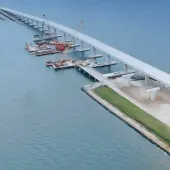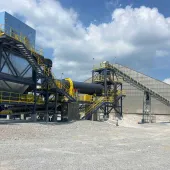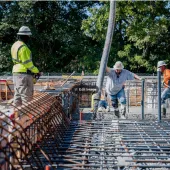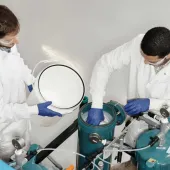Doctoral student helps create self-healing concrete additive
Researchers at Drexel University’s College of Engineering in Pennsylvania, US have developed an innovative self-healing concrete technology called BioFiber. The novel BioFibers enable concrete to autonomously heal cracks and damage using bacterial spores that precipitate calcium carbonate to seal fractures.
The technology was developed through a collaboration between the departments of Civil, Architectural and Environmental Engineering (CAEE), Mechanical Engineering and Mechanics, and Material Science and Engineering, led by PhD candidate Mohammad Houshmand, who was introduced to the project while working with Amir Farnam, PhD, associate professor of CAEE, in the Advanced Infrastructure Materials (AIM) Lab.
“Two years into my doctoral journey, Professor Farnam and I explored the collaborative potential of my involvement in the BioFiber project, which eventually became the focal point of my PhD dissertation,” Houshmand explained. “Subsequently, I assumed the lead role as the PhD student spearheading the development of BioFiber technology.”
The novel BioFibers provide concrete with three key capabilities: self-healing, crack growth control, and damage-responsiveness. They are made of a core fiber surrounded by a hydrogel sheath containing dormant bacterial spores, all encased in a polymeric outer shell. When a crack forms in the concrete and ruptures the BioFiber, water penetrates and causes the hydrogel to swell and the bacteria to produce calcium carbonate, which seals the crack, healing the damage in the concrete.
Houshmand says that the team leveraged strategies from multiple disciplines to optimize the BioFibers, a practice that Houshmand says enriched his experience as a PhD student.
"Navigating the interplay between material science, microbiology and manufacturing processes ensured that the technology would be successful," he stated. “Collaborating with faculty researchers and peers has significantly contributed to my growth as a researcher. Engaging with experienced faculty members provided valuable mentorship and refined my research approach, while collaborating with fellow students fostered an environment for idea exchange and enhanced problem-solving skills.”
One of the highlights of the BioFiber technology, according to Houshmand, is its potential to enhance sustainability in infrastructure and construction. The self-healing functionality provided by the bacterial spores can extend the service life of concrete structures and reduce the need for repairs and maintenance. This in turn lowers material demands, transport emissions, and waste. BioFibers align with Houshmand's passion for developing eco-friendly construction advances.
"The prospect of contributing to the development of resilient, eco-friendly infrastructure, capable of prolonged functionality and reduced maintenance, inspires my dedication to this innovative field," he added.
Upon completing his PhD, Houshmand aims to leverage the knowledge and experience gained in the development of BioFiber to establish a startup to bring the technology to market.
“I am passionate about commercializing this groundbreaking technology to revolutionize the construction industry and contribute to sustainable infrastructure development on a larger scale,” he said. “By founding a company dedicated to the production and implementation of BioFiber, I aspire to drive widespread adoption and create a positive impact on the global construction landscape, ultimately contributing to a more sustainable and resilient built environment.”







